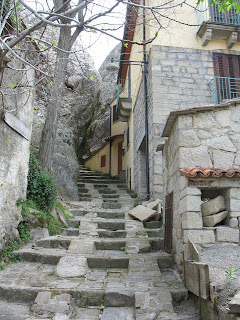Holy Week here in Florence was quite an experience. We were able to choose from a myriad of free concerts almost every night. One night we went to Santa Croce for Verdi's Requiem. What a setting! Good enough to house the remains of Michelangelo, Rossini and Galileo. Galileo was moved there after it was decided that the earth did, indeed, revolve around the sun about a hundred years after his death. Unfortunately the acoustics in the church weren't great and the sound didn't carry well.
 |
| Santa Croce cloister |
 |
| Altar of a side chapel |
 |
| Galileo's tomb in Santa Croce |
The next night we attended a smaller concert held in the American Episcopal Church (St James, Diocese of Europe) given by the Duomo Choir which was also very well received. Afterward they provided a lovely reception with wonderful Italian goodies. We went back to the American Episcopal Church for Easter Vigil on Saturday night. It started with the congregation lighting candles from the Baptismal Candle which was "decorated" with nails in the form of a cross. Baby Emmanuel was christened that night in keeping with Episcopal tradition. We are happy to report that there was no incense used, so Theresa was able to stay in the service.
After the service conducted by Father Mark Duncan, Dottie Duncan, his wife, had made dinner for all of us. The Duncans are from Alabama. Italians often eat a first course (primo piatto) and second course (secondo piatto). In this case Dottie made a wonderful rice dish with black eyed peas for the first course. We didn't even know you could find black-eyed peas in Italy! Second course was roast pork (very common here), chilled pickled onions, turnips, broccoli, and bread. Of course there's dessert and this time it was cake, cookies and strawberries.
On Sunday we got up early enough to be in Piazza del Duomo to get a great place to see the Scoppio del Carro......or the exploding cart. The term "duomo" comes from the Latin "domus deo" or "house of God".
 |
| The Piazza is empty when we arrive at 9 AM........ |
There are two parades from two sides of the city. Both have paraders in medieval costumes, flag bearers, trumpets, and drums. One group is led by white oxen decorated with flowers
pulling a 20 foot high cart that has the fireworks
 |
| The cart arrives, covered with plastic due to the threat of rain (it didn't). You can see that the piazza has filled up rapidly. |
Video of a flag routine in front of the Duomo
 | ||||
| costumed paraders |
 |
| and musicians |
 |
| And finally a priest carrying the holy fire arrives |
 |
| Finally the priest and his entourage come out of the church to bless the cart and the fire and everything else in sight |
Video of fireworks from the cart
More video of fireworks, including the bells that rang incessantly
 |
| and multi-colored smoke |
When we arrived around 9AM, there were very few people there. I thought that maybe we would see a couple of hundred people. By 11, when the arrow left the church there were thousands in the piazza. We never saw so many people converge in so little time in our lives. In America people would have been sleeping outside all night. Not Florence. The idea was to come when you want and just push where you want to be.......all very Italian.
Our Easter in Italy was as memorable as our daughter Laura said it would be. No Easter baskets (except the one Ken fashioned for me).
 |
| Our Easter basket and the "Colomba" that the Montini's (our landlords) gave us |












































